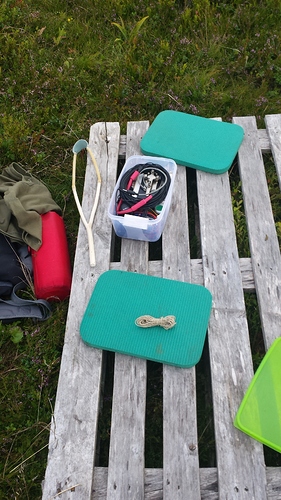There are a lot of ways to get your wire up in the air for a successful SOTA activation. You can use a collapsible pole, a handy structure, or use nature’s poles that we know as trees. Poles and structures don’t present much difficulty - but trees? Well, they just stand there and dare you to get your antenna up in them, offering no help whatsoever. They are patient and have no skin in the game - it is up to you to meet them half way.
So what’s an activator to do? Sure, you could carry a pneumatic spud-gun like the ones you see at hamfests.

Heavy, attracts the wrong kind of attention, probably illegal in many places. So… no. Same goes for slingshots and bows an arrows in most spots.
Climb the tree? Not at my time of life thankyouverymuch! Besides, trees compete amongst themselves to be as unclimbable as possible, especially on summits. Unless you plan to pack along a rhesus monkey to do your climbing for you (hey, goats shouldn’t get all the SOTA fun, right?), climbing is out too. What’s left?
“Throwing!”, I hear you shout.
Now you are on the right track. But there is throwing and then there is throwing. Raring back and making a baseball style throw seems the easiest approach, yet it falls short. You’ll blow out your shoulder if you throw too light a weight. Too heavy and you won’t get much distance. It’s exhausting. The attached line tends to wrap around you after the release, too. It’s a mess. I know, I’ve tried it many times over the years. There must be an alternative, right?
If you’ve never seen an arborist/tree surgeon at work, you’ve missed a treat. They do a lot with a little, and much of it involves ropes used in cunning ways. Throwing line into trees is their bread and butter. How do they do it? They use what’s called a “throw bag”. It’s a weighted sack, usually about 4-10 ounces (120-300 grams, approx). The throwline attached to the bag is light, slippery stuff to slide through the tree easily and return to the ground.
Let’s look at the throwing technique first, then cover the equipment in more detail (there are some adaptations specific to SOTA needs, so don’t take the equipment you see as gospel). Here are a couple of videos on how to use the throwline. This stuff really works! It’s accurate with a bit of practice, and can throw a line an amazing height. All this without stress and strain on the joints or exhausting yourself.
Alternate “between the legs” technique (I use this one for preference if circumstances allow)
That throwing line bag in the vids looks like a hassle, doesn’t it? Who would want to pack that up the mountain? There’s a nice alternative that works beautifully on the summit.
You can buy this type of reel on eBay for small change.
You can buy or make the weight yourself, or even use a small plastic soda bottle with some water in it. I’ve decided on a weight, because my plastic soda bottle shattered on landing. Weights are slimmer and less likely to hang up. If you are the DIY sort, you can make your own weight. Some people just carry an empty weight sack and use local sand/rocks to fill it once on site. There are lots of ways to go. Take a look at this supplier to get an idea. The “chain weight” style is very DIY friendly if you have some tubular nylon webbing and some hand stitching skills. A 6 ounce/170g weight seems about right for me.
http://www.wesspur.com/Throw-line/throw-bags.html
(chain weight style for DIY shown here)
http://www.wesspur.com/images/treegear/thr228-group-500.gif
Arborists use specialized throwline, but I’ve gone lighter for less bulk. The reduced diameter makes it a bit harder to hold when throwing, but using loops seems to control that. I use fluorescent colored braided dyneema/Spectra fishing line. 200 pound test works fine, and 300 pound should get you a little more diameter for handling if you are concerned. 100 meters will be plenty, but it’s useful stuff and you might want more.
http://www.ebay.com/itm/300M-6lb-300lb-Hercules-PE-test-Strong-Dyneema-4S-8S-Braid-Fishing-Line-Spectra-/291828518873?var=&hash=item43f255cfd9:m:mU-kY6Mcgp-L_S1iXCGu2WQ
So there you have it, a lightweight, simple way to get your antenna into the trees. Practice at home before taking to the field, of course. Hope this helps.
Post Script:
Here is a fun video of an intrepid arborist rescuing a cat from a very tall tree. He’s braver than I am!






